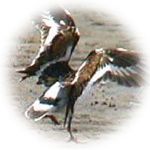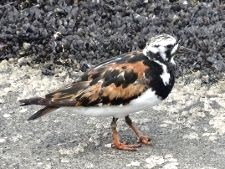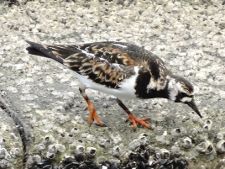<Natsubah> <I'm Natsuha>
 The water terrace at the bottom of Ishikawajima Park is full of jogging, walking, and dog walks.
The water terrace at the bottom of Ishikawajima Park is full of jogging, walking, and dog walks.
During this season, at low tide, if you look closely at the rocky shores of the water, you can see ruddy turnstone (ruddy turnstone) moving around and foraging.
The origin of the Japanese name is that the summer feathers with a flashy reddish brown and black (like a triple cat) pattern on the back and wings are regarded as Kyoto's kimono.
♂In summer feathers, the white and black vertical spots at the top of the head are clear, and the reddish brown part on the upper surface of the body is vivid and has strong redness.
♀In summer feathers, the upper part of the head is mixed with grayish-brown, and the reddish-brown part on the upper surface of the body is smaller than mm and has weak redness.
(By the way, winter feathers are black-brown on the head and the upper surface of the body, have a reddish color, and have a plain color.)
It breeds in the Tundra area in northern Eurasia and northern America in summer, and is said to winter over the coasts of South Asia, Africa, Central and South America and Oceania in winter. In Japan, as a traveling bird, it flies as a relay point mainly in spring, mainly in May, and autumn mainly in September, and is observed in tidal flats, coasts, paddy fields, etc.
The total length is about 22cm.
A sloppy body shape.
Black and short beak.
Orange legs.
The squeal is "Geregret."
When flying, the white part of the wings, waist and tail stands out.
In addition to surface foraging, it seems to catch small animals lurking underneath by turning or shifting pebbles, earth lumps, shells, and seaweed lumps with beaks.
The English name (Ruddy) Turnstone is associated with foraging habits.
If you have the opportunity to go to the waterside of tidal flats and reefs during this season, be careful and look for it.
You may be able to meet an unusual, small "Kyojo"!



